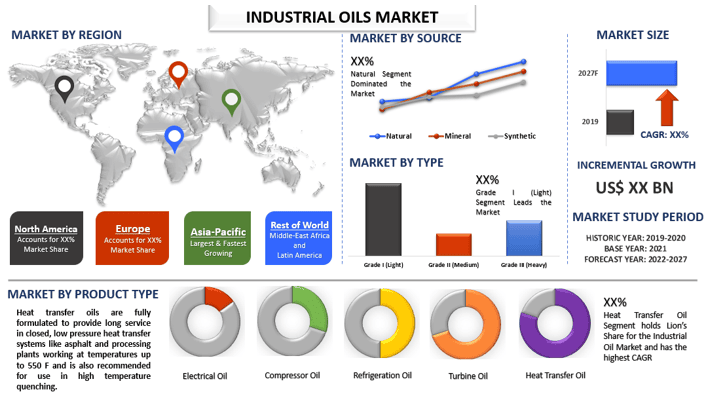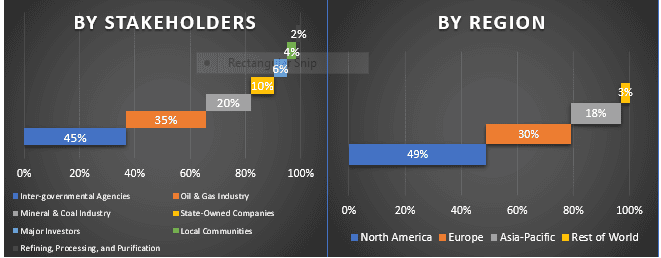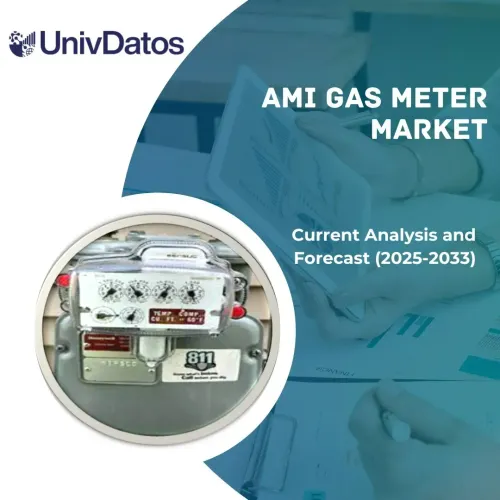- Home
- About Us
- Industry
- Services
- Reading
- Contact Us
Industrial Oil Market: Current Analysis and Forecast (2021-2027)
Emphasis on Source (Natural, Mineral, Synthetic); Product Type (Turbine Oil, Refrigeration Oil, Compressor Oil, Electrical Oil, Heat Transfer Oil); Type (Grade I (Light), Grade II (Medium), and Grade III (Heavy)); End-Use (Automotive, Engineering, Automation, Manufacturing, Food processing, Oil & Gas, Medical); Region/Country

Industrial Oils Market is expected to exceed the market valuation of than US$ 90.1 billion in 2027 and is expected to grow at a significant CAGR of 5.8% during the forecast period (2021-2027). Industrial oils are petroleum oils that are used for the lubrication of machinery at home or in industries. Crude oils like Baku, Emba and eastern types are used to produce these. Industrial oils can sometimes contain vegetable oils. Industrial oils also contain little mixtures of vegetable oils like castor, mustard, rapeseed as additives and a few thickenings, antioxidant, and anticorrosive dopes used for improving their service qualities. Industrial oils are also constantly being varied and supplemented with new brands, especially synthetic oils like silicon, fluorohydrocarbon and polyester. According to viscosity, industrial oils can be subdivided into light, medium and heavy types. Light oils have the viscosity of 5-10 centistokes at 50 C, these are used to lubricate high-speed, low-load machinery.
The dynamics of the industry are changing in terms of source, as industries are shifting towards biobased lubricants as compared to synthetic or mineral sources which were popular before. According to USDA and other regulatory organizations, when at least 50% or greater amount of material is used in the industrial oil formulation, it is to be considered a bio-based industrial oil. Trade of vehicles and their spare parts is constantly growing and is expected to fuel the growth of automotive oils and greases. The growth of the industrial oils market is directly proportional to the growth of the manufacturing sector. The manufacturing sector is growing due to favorable foreign investments and increasing pool of skilled labors. Additionally, high growth in niche manufacturing sectors like the medical devices and 3D printing sectors is also complementing the industrial oils market growth. Rapid industrialization in the BRICS countries is expected to drive this growth rate in the industrial oils market.
Worldwide Consumption of Different Vegetable Oils (million metric tons), 2013-14 to 2020-21
Industrial Oils Market 1Cargill, Bunge Limited, Wilmar International, Louis Dreyfus Company B.V., Archer Daniels Midland (ADM), Buhler Group, CHS Inc., Ag Processing Inc., A&A Fratelli Parodi Spa, and Gemtek Products. are some of the prominent players operating in the Industrial Oils market. Several M&As along with partnerships have been undertaken by these players to facilitate customers with hi-tech and innovative products/technologies.
Insights Presented in the Report
“Amongst Source, Natural segment holds the major share”
Based on source, the industrial oils market is segmented into Natural, Mineral, and Synthetic. Amongst source, the natural segment of the market held significant market share in 2020. Natural industrial oils, more commonly known as bio-based industrial oils have gained tremendous popularity over the last decade. Usage of mineral-based oils heavily relies on extracting from petroleum products.
“Amongst Product Type, Heat Transfer Oil Segment holds the major share”
Based on Product Type, the industrial oils market is segmented into Turbine Oil, Refrigeration Oil, Compressor Oil, Electrical Oil, and Heat Transfer Oil. Amongst product type, Heat Transfer Oil segment accounted for significant market share. Heat transfer oil is needed in many industrial applications and for heating homes during the winter. Heat is provided indirectly by hot oil through the heat exchanger, which reduces hotspots and increases the safety of the heating process.
“Amongst Type, Grade I (Light) Segment holds the major share”
Based on Type, the industrial oil market is segmented into Grade I (Light), Grade II (Medium), and Grade III (Heavy). The Grade I segment accounted for significant market share in 2020. Group I base oils has less than 90% saturates, viscosity-index range of 80-120 and greater than 0.03% sulfur. Their temperature ranges from 32-150 degrees F.
“Amongst End-Use, Automotive segment holds the major share”
Based on end-use, the industrial oils market is segmented into Automotive, Engineering, Automation, Manufacturing, Food processing, Oil & Gas, and Medical. Amongst end-user, the automotive segment of the market accounted for the significant market share in 2020. Nowadays, automakers are stiving for extended warranties and promising longer intervals between vehicles services. This requires the use of good quality lubricants to ensure the vehicles longer and efficient functions.
“Asia Pacific represents one of the largest markets of Industrial Oils market”
For a better understanding of the market dynamics of the Industrial Oils market, a detailed analysis was conducted for different regions across the globe including North America (the U.S, Canada, and the Rest of North America), Europe (Germany, France, Italy, United Kingdom, Spain, and Rest of Europe), Asia-Pacific (China, Japan, India, Australia, and Rest of APAC) and Rest of the World. Asia Pacific dominated the market owing to increased industrialization in the region.
Reasons to buy this report:
- The study includes market sizing and forecasting analysis validated by authenticated key industry experts
- The report presents a quick review of overall industry performance at one glance
- The report covers an in-depth analysis of prominent industry peers with a primary focus on key business financials, product portfolio, expansion strategies, and recent developments
- Detailed examination of drivers, restraints, key trends, and opportunities prevailing in the industry
- The study comprehensively covers the market across different segments
- Deep dive regional level analysis of the industry
Customization Options:
Industrial Oils market can further be customized as per the requirement or any other market segment. Besides this, UMI understands that you may have your own business needs, hence feel free to connect with us to get a report that completely suits your requirements.
Table of Content
Analyzing the historical market, estimation of the current market, and forecasting the future market of the Industrial Oils market were the three major steps undertaken to create and analyze the adoption of Industrial Oils in major regions globally. Exhaustive secondary research was conducted to collect the historical market numbers and estimate the current market size. Secondly, to validate these insights, numerous findings and assumptions were taken into consideration. Moreover, exhaustive primary interviews were also conducted, with industry experts across the value chain of the Industrial Oils market. Post assumption and validation of market numbers through primary interviews, we employed a top-down/bottom-up approach to forecasting the complete market size. Thereafter, market breakdown and data triangulation methods were adopted to estimate and analyze the market size of segments and sub-segments the industry pertains to. Detailed methodology is explained below:
Analysis of Historical Market Size
Step 1: In-Depth Study of Secondary Sources:
Detail secondary study was conducted to obtain the historical market size of the Industrial Oils through company internal sources such as annual report & financial statements, performance presentations, press releases, etc., and external sources including journals, news & articles, government publications, competitor publications, sector reports, third-party database, and other credible publications.
Step 2: Market Segmentation:
After obtaining the historical market size of the Industrial Oils market, we conducted a detailed secondary analysis to gather historical market insights and share for different segments & sub-segments for major regions. Major segments included in the report as Source, Product Type, Type and End-Use. Further country-level analyses were conducted to evaluate the overall adoption of Industrial Oils in that region.
Step 3: Factor Analysis:
After acquiring the historical market size of different segments and sub-segments, we conducted a detailed factor analysis to estimate the current market size of Industrial Oils. Further, we conducted factor analysis using dependent and independent variables such as increasing urbanization and industrialization. A thorough analysis was conducted for demand and supply-side scenarios considering top partnerships, merger and acquisition, business expansion, and product launches in the Industrial Oils sector across the globe.
Current Market Size Estimate & Forecast
Current Market Sizing: Based on actionable insights from the above 3 steps, we arrived at the current market size, key players in the Industrial Oils market, and market shares of the segments. All the required percentage shares split, and market breakdowns were determined using the above-mentioned secondary approach and were verified through primary interviews.
Estimation & Forecasting: For market estimation and forecast, weights were assigned to different factors including drivers & trends, restraints, and opportunities available for the stakeholders. After analyzing these factors, relevant forecasting techniques i.e., top-down/bottom-up approach was applied to arrive at the market forecast about 2027 for different segments and subsegments across the major markets globally. The research methodology adopted to estimate the market size encompasses:
- The industry’s market size, in terms of value (US$) and the adoption rate of Industrial Oils across the major markets domestically
- All percentage shares, splits, and breakdowns of market segments and sub-segments
- Key players in the Industrial Oils market in terms of products offered. Also, the growth strategies adopted by these players to compete in the fast-growing market
Market Size and Share Validation
Primary Research: In-depth interviews were conducted with the Key Opinion Leaders (KOLs) including Top Level Executives (CXO/VPs, Sales Head, Marketing Head, Operational Head, and Regional Head, Country Head, etc.) across major regions. Primary research findings were then summarized, and statistical analysis was performed to prove the stated hypothesis. Inputs from primary research were consolidated with secondary findings, hence turning information into actionable insights.
Split of Primary Participants in Different Regions
Market Engineering
Data triangulation technique was employed to complete the overall market estimation and to arrive at precise statistical numbers of each segment and sub-segment of the Industrial Oils market. Data was split into several segments & sub-segments post studying various parameters and trends in the areas of type and their type of the Industrial Oils market.
The main objective of the Industrial Oils Market Study
The current & future market trends of Industrial Oils were pinpointed in the study. Investors can gain strategic insights to base their discretion for investments from the qualitative and quantitative analysis performed in the study. Current and future market trends were determined the overall attractiveness of the market at a regional level, providing a platform for the industrial participant to exploit the untapped market to benefit as a first-mover advantage. Other quantitative goals of the studies include:
- Analyze the current and forecast market size of Industrial Oils in terms of value (US$). Also, analyze the current and forecast market size of different segments and sub-segments
- Segments in the study include areas of type and their subtypes
- Define and analysis of the regulatory framework for the Industrial Oils industry
- Analyze the value chain involved with the presence of various intermediaries, along with analyzing customer and competitor behaviors of the industry
- Analyze the current and forecast market size of the Industrial Oils market for the major region
- Major regions studied in the report include North America (the U.S, Canada, and Rest of North America), Europe (Germany, United Kingdom, France, Spain, Italy, and Rest of Europe), Asia-Pacific (China, Japan, India, Australia, and Others), and the Rest of the World
- Company profiles of the Industrial Oils market and the growth strategies adopted by the market players to sustain in the fast-growing market
Deep dive regional level analysis of the industry
Related Reports
Customers who bought this item also bought










